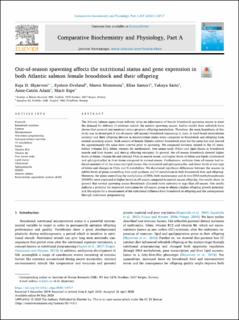| dc.description.abstract | The Atlantic salmon aquaculture industry relies on adjustments of female broodstock spawning season to meet the demand for delivery of embryos outside the natural spawning season. Earlier results from zebrafish have shown that parental micronutrient status program offspring metabolism. Therefore, the main hypothesis of this study was to investigate if out-of-season (off-season) broodstock (spawning in June, in land-based recirculation systems) and their offspring deviate in micronutrient status when compared to broodstock and offspring from normal spawning season. Both seasons of female Atlantic salmon broodstock were fed the same diet and starved for approximately the same time interval prior to spawning. We compared nutrients related to the 1C metabolism (vitamin B12, folate, vitamin B6, methionine), free amino acids (FAAs) and lipid classes in broodstock muscle and liver tissues, and during offspring ontogeny. In general, the off-season broodstock showed higher levels of folate, vitamin B6 and selected FAAs in muscle tissue, and higher levels of folate and lipids (cholesterol and sphingomyelin) in liver tissue compared to normal-season. Furthermore, embryos from off-season had reduced amounts of all the measured lipid classes, like cholesterol and sphingomyelin, and lower levels of one type of folate and changes in FAAs and N-metabolites. We discovered significant differences between the seasons in mRNA levels of genes controlling fatty acid synthesis and 1C metabolism in both broodstock liver and offspring. Moreover, for genes controlling the methylation of DNA; both maintenance and de novo DNA methyltransferases (DNMTs) were expressed at higher levels in off-season compared to normal-season offspring. Our results show, in general that normal spawning season broodstock allocated more nutrients to eggs than off-season. Our results indicate a potential for improved maturation for off-season group to obtain a higher offspring growth potential, and this argues for a reassessment of the nutritional influence from broodstock to offspring and the consequences through nutritional programming. | en_US |
